Hitches and Towing 101
| CHAPTER CONTENTS | |
| 1. Introduction to Towing | 7. Brake Controls |
| 2. Towing Components | 8. Hitch Installation |
| 3. Types of Hitches | 9. Hooking Up |
| 4. Determining Tow Capacity | 10. Tow Bars/Dinghy Towing |
| 5. Selecting Your Hitch | 11. Towing Safety |
| 6. Wiring/Electrical | 12. Preparing Your Tow Vehicle |
Chapter 4 - Determining
Towing Capacity
It is critical that you understand your vehicle's maximum towing capacity
before you begin towing. If you exceed the manufacturer's rated capacity you are
creating an unsafe driving situation, and you are very likely to damage your
vehicle's engine, transmission, rear axle, brakes and wheel bearings, and you
will void the manufacturer's warranty.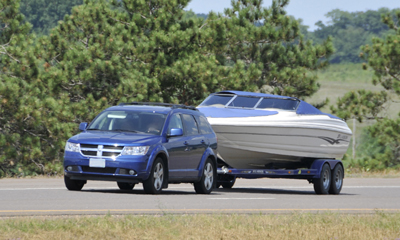
If
you have not yet purchased a tow vehicle, remember that in general, AWD and 4WD
vehicles have a lower towing capacity than a comparable 2WD vehicle. Pickup
trucks with extra-cab and crew cab designs also tend to have lower towing
capacity than comparable standard cab designs. It pays to research towing
capacities thoroughly before you buy, and it's always best to buy a tow vehicle
with a much larger towing capacity than you intend to use.
Checking Your Vehicle's Owner's Manual
Your best
means of determining your vehicle's towing capacity is to read your vehicle's
owner's manual and to compare the information there with the certification plate
on your driver's door sill. The owner's manual will provide detailed
instructions and limitations, usually accompanied by tips for safe towing.
For example, the 2000 model year owner's manual for a Ford Crown
Victoria includes the following statement:
TRAILER
TOWING
Your vehicle is classified as a light duty towing
vehicle. Do not tow a trailer until your vehicle has been driven at least 3,200
km (2,000 miles). Towing a trailer places an additional load on your vehicle's
engine, transmission, brakes, tires and suspension. Inspect these components
carefully after towing. Your loaded trailer should weigh no more than 907 kg
(2,000 lbs.).
The owner's manual of the 2005 Jeep Liberty offers
even more detail, as shown in Figure 4-1: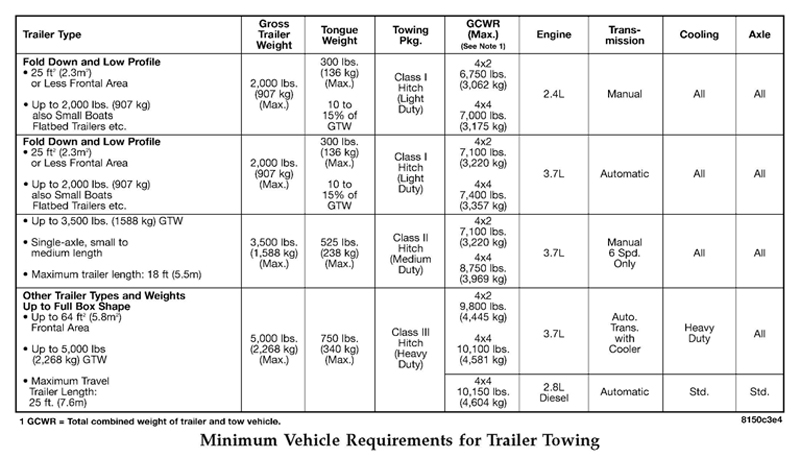
Figure
4-1: Towing Capacity Chart (click
image to enlarge)
If your vehicle is not capable of towing
any trailer, that will be stated explicitly in your owner's manual. If you do
not have a copy of your owner's manual, many automakers allow you download a
copy freely from the Internet.
Finding Your Vehicle's Compliance
Certification Label
After you've read your vehicle owner's
manual, it's a good idea to double check the compliance certification label.
This is typically a sticker placed somewhere in the driver's door sill area.
This label will have several fields, labeled with acronyms such as "GVR," "GAW,"
and "GCWR." These fields are defined as follows:
Gross
Vehicle Weight (GVW)
This is the vehicle's standard curb
weight, plus an allowance for a standard amount of luggage, gas and passengers,
as predicted by the manufacturer. Of course, your vehicle's actual weight will
vary depending on how much luggage, gasoline, and passenger weight you have
actually placed in the vehicle, so the GVW is an
approximation.
Gross Vehicle Weight Rating (GVWR)
This is the maximum safe actual weight of your vehicle. If you
exceed this weight, the vehicle's engine, transmission, brakes, and so on will
be stressed beyond their design limits.
Gross Combination
Weight (GCW)
This is the actual weight of your vehicle (GVW)
plus the actual total weight (not the tongue weight) of your trailer. This
number must not be higher than your vehicle's GCWR.
Gross
Combination Weight Rating (GCWR)
This is the maximum safe
weight of your combined vehicle and trailer. This weight includes all people,
luggage, and other material. If your combined towing setup exceeds this weight,
your vehicle's engine, transmission, brakes, and so on will be stressed beyond
their design limits.
Gross Axle Weight
(GAW)
These numbers are the weights expected to be placed on
your vehicle's front and rear wheels. The two numbers are likely to be different
to account for engine weight and other factors.
Gross Axle
Weight Rating (GAWR)
This is the maximum safe weight that can
be placed on your front or rear wheels. The two numbers are likely to be
different to account for engine weight and trailer tongue weight and luggage. If
you exceed this weight rating on either the front or rear tires, you can create
a dangerous driving situation or even damage your
vehicle.
Checking Trailer Weight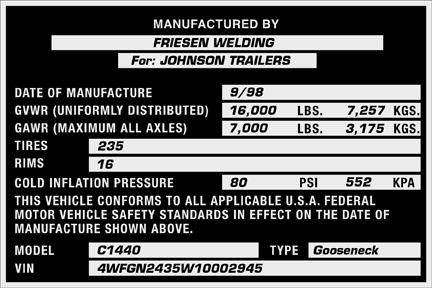

After
you understand your vehicle's weight capacities and general towing capacity, you
need to learn your trailer's weight. Unless your trailer is home-built, it will
have a VIN (Vehicle Identification Number) plate installed somewhere. This plate
not only carries the trailer's serial number, it also lists the trailer's
unloaded GVW and a maximum GVWR for the trailer and a GAWR for each axle on the
trailer.
Figures 4-2 shows representative weights for a number of
commonly-used utility trailer styles. 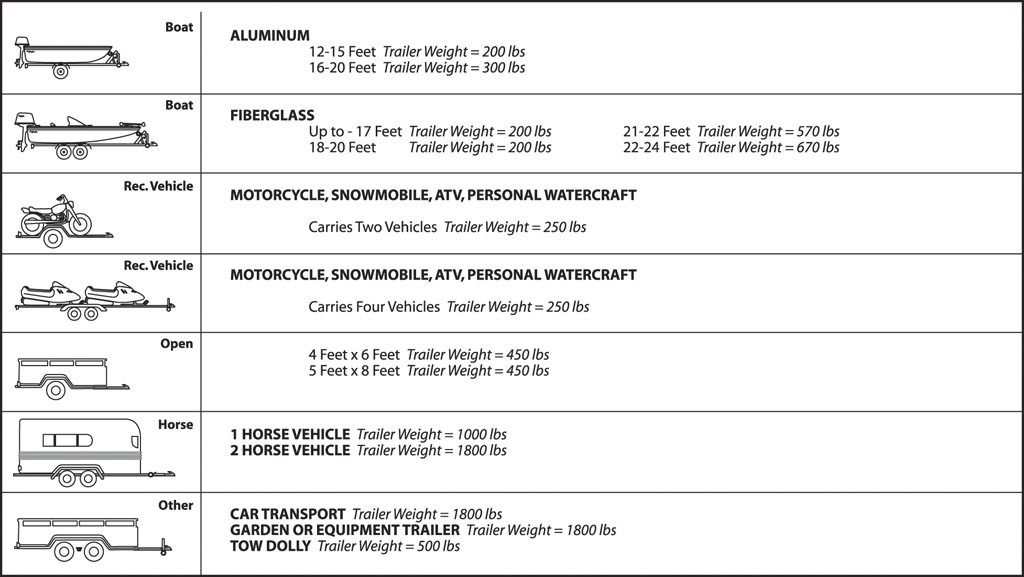
Figure
4-2: Example Utility Trailer Weights (click image to enlarge)
Figure
4-3 shows representative weights for camping and travel trailers, and also
relates those standard trailer weights to appropriate hitch classes.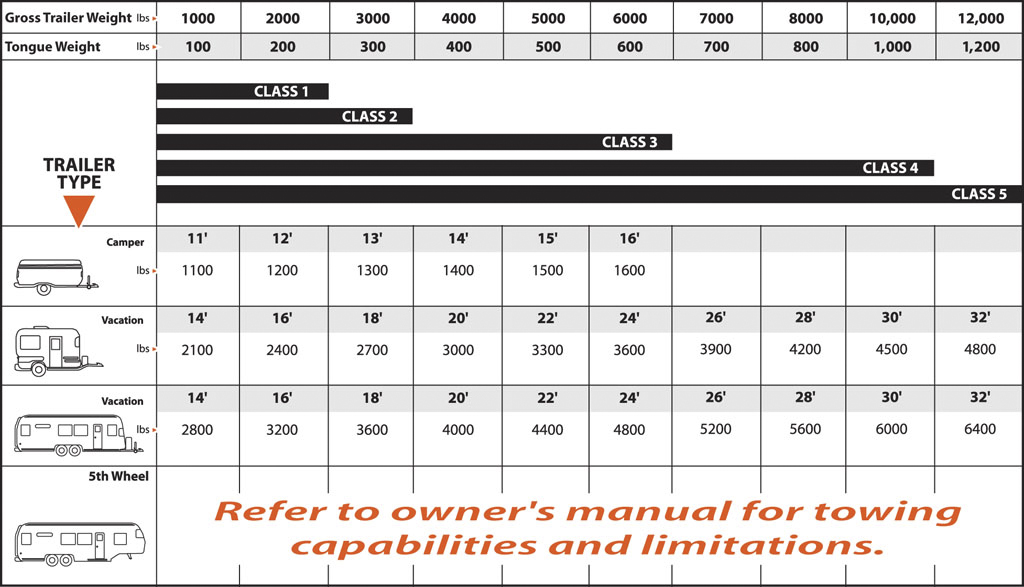
Figure
4-3: Example Travel Trailer Weights (click image to enlarge)
If you
don't have access to a VIN plate or other weight information for your trailer,
or if it's hard to estimate the total weight you're adding to the base GVW of
the trailer, the best way to find the weight is to load your trailer as you
expect to use it and take it to a vehicle scale. Such scales are sometimes
available to recreational users at state highway weigh stations, refuse transfer
stations, and commercial truck stops. The advantage of this method is that you
learn the actual weight of your loaded trailer. Be sure to call ahead and
confirm that you are welcome to use these scales, however.
Checking Tongue Weight
The last capacity you
have to consider is your trailer's tongue weight. That's the weight on the
coupler when your trailer is fully loaded and ready to go. In general, you want
to try for about 10% of the total trailer weight to be carried on the tongue.
Most receivers and other hitches assume that the tongue weight will be abut 10%,
and sticking to this ratio helps improve your towing experience.
You can
check your trailer's tongue weight with a specialized scale, available for about
$150 at trailer supply shops. But since you probably don't need to scale your
trailer's tongue weight very often, you can call and ask if your local trailer
dealer has a tongue scale you can use. Chances are you'll have to take your
trailer to the dealer to be weighed.
You can also take your trailer's
tongue weight with a common bathroom scale if it's less than about 300 pounds.
If the weight is greater than 300 pounds, you can use some boards and pipes and
set up a test as shown in Figure 4-4: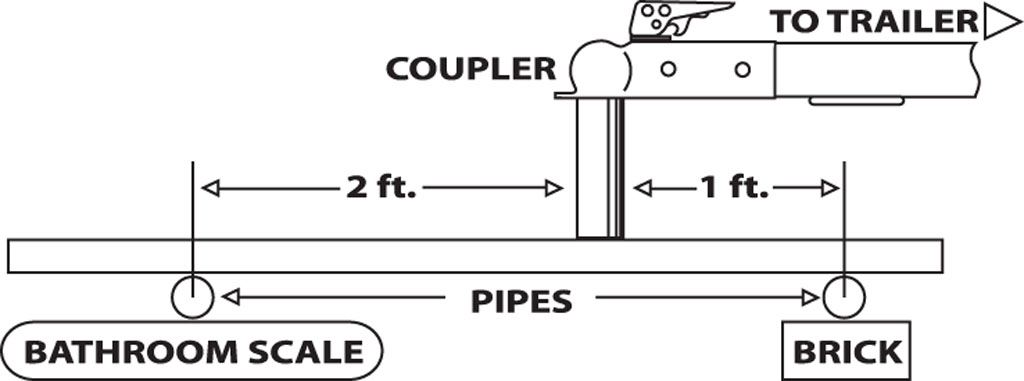
Figure
4-4: Measuring Tongue Weight
Using this setup, you take a
reading off the bathroom scale and triple it to find your actual tongue
weight.
Note that you can change your trailer's tongue weight
substantially by changing the way you load the trailer. If you place more weight
in front of your trailer's axle(s), you will generate more tongue weight. If you
place too much weight behind the axle(s), you can actually generate negative
tongue weight.
If you have too much tongue weight, your combined tow rig
will sag at the coupler and you will find that your tow vehicle has to work much
harder to pull the load. If you do not have enough tongue weight, your trailer
will tend to wander and if you have negative tongue weight, your vehicle's rear
tire traction can be reduced with dangerous consequences. Always strive for
about 10% tongue weight and you'll get better results.
| << Back to Chapter 3 | Go to Chapter 5 >> |




